
Bluestone is one of several types of flagstones that can be installed in patios, decks, porches or interior settings. However, unlike setting tile where a mortar bed is all that is needed, flagstones need a thick bed of packing mortar, usually a few inches thick. This packing material may have sand and cement in it, but it isn't rated for adhesion. Instead, you need to use a cement slurry for actually setting the stones in raw packing material.
Packing Base
Video of the Day
The packing base for setting flagstone type material is generally a mixture of three parts sand to one part cement with just enough water to create a packable material. It is spread down onto the installation surface at least a few inches thick and then packed down with a tamper or machine. The stone is then installed on top of this base and tapped into place with a mallet until it is level or flat with the surrounding pieces.
Video of the Day
Cement Slurry
Used in a variety of installations that involve raw stone, cement slurry is a mixture of raw cement mixed with water to achieve a paintable solution. This slurry is then painted onto the backs of the stones as they are set into the bed of fresh packing material, which causes the packing material to bond with the slurry, which is already bonded to the back of the stone.
Type of Cement
The type of cement you use for your slurry mixture when setting bluestone is the same as what you include in the packing mixture when you are mixing it. Portland cement is the most common type available in home improvement stores around the world, and it has been in use for thousands of years. It is the binding agent in concrete and mortars, and can be painted onto the backs of the stones to help them adhere to the packing.
Raw Setting
The most vital part of the bluestone installation is setting the material into the fresh packing mud. If you wait until the packing material has had a chance to set up, the cement slurry you paint onto the backs of the stones won't bond with the packing mud. Plus, once the packing mud hardens you can't tamp the pieces down into the mud to achieve a level or flat surface, as it will be hard like concrete.